Protaetia (Netocia) afflicta Gory and Percheron, 1833 (Cetonia)
Cetonia afflicta Gory and Percheron, in: Monographie des cetoines et des genres voisins, formant dans la famille naturelles de Latreille, la division des Scarabees melitophiles, Paris, 59, 215, pl.40, fig.1.
Cetonia servillii Burmeister, 1842, in: Handbuch der Entomologie, III, Coleoptera Lamellicornia Melatophila, Berlin, p.447, ou Burmeister reprend le taxon Cetonia servillii Gory in litt.
French
Cette Netocia est en general facilement identifiable par l‘enduit mat prunieux du dessus de la forme typique, par sa grande saillie mesosternale, par son front a ponctuation dense tres grossiere et par le dessous des tibias posterieurs avec un sillon longitudinal mat densement ponctue et pubescent, au droit de la rangee de poils ciliformes.
La Cetoine noire mat est bien tranchee des autres especes du sous-genre Netocia. Son chromatisme noir pruineux peut evoluer rarement vers une couleur vert noiratre, voire bronze cuivreux, et les elytres peuvent plus ou moins largement taches de macules blanches. Ces principales variations chromatiques ont ete nommees avec les aberrations suivantes:
- libanii Gory et Percheron, 1833, avec le dessus noir verdatre mat et le dessous noir verdatre brillant connue de Syrie, Liban et Jerusalem;
- titea Reitter, 1898, entierement vert metallique sur le dessous et connue de Turquie;
- leucogramma Gory et Percheron, 1833, avec le dessus vert fonce brillant au niveau de la tete et la partie anterieure du pronotum, la partie posterieure est vert noir et des taches blanches se developpent sur les elytres; elle est connue dans la region de Izmir en Turquie;
- osmanlis Gory et Percheron, 1833, avec le dessus et le dessous vert noiratre, tres lisse et des taches blanches transversales sur les elytres;
- atrocoerulea Walt, 1838, avec le dessous bleu a bleu-vert, des petites macules blanches sur les elytres et le dessus du corps est bleu noir, decrite de Tokat en Turquie.
C‘est une cetoine commune, largement representee en Anatolie de l‘ouest et au Levant. Elle peut etre tres abondante sur la bordure ctiere orientale de la mediterranee, dans des biotopes ou les arbres sont rares, voire absents. Son aire de distribution est importante, de la Grece continentale (Peloponnese, Attique), dans les iles Grecques de la mer Egee, en Crete, dans les iles de Rhodes et de Chypre, en Turquie sur la zone littorale de la mer de Marmara et de la mer Egee, dans le Taurus, dans la chaine pontique et dans le Hatay, en Syrie, Liban, Israel, Palestine, Jordanie et territoire de Gaza, Egypte, Arabie Saoudite et Yemen.
Sur le Sinai, en Egypte (ou Alfieri 1976 la signale en 1976 du monastere Saint Katherin), en Arabie (region de Taif) et au Yemen, l‘espece afflicta presente une nette variation chromatique avec le dessous bleu noir, et le dessus bronze luisant avec de petites macules blanches sur les elytres, ou elle a ete nommee par Burmeister en 1842, comme Cetonia servillii. Cette variete remplace completement la forme nominative et prend dans ce secteur la valeur d‘une veritable race geographique sous le nom de Protaetia (Netocia) afficta ssp. servillii Burmeister, 1842 combinatio nova).
Les larves se developpent le plus souvent dans des zones peu boisees, en terre dans le terreau et les residus de bulbes et racines fraichement decomposees d‘Onopordum, d‘Echinops et de Cirsium. On l‘a observe aussi dans le Hatay (Turquie SE) a l‘interieur d‘un terreau environnant les racines d‘Olea sp. et dans des tas de composts agricoles divers. Les imagos peuvent s‘observer de mai a juillet sur les fleurs de Onopordon et Verbascum.
English
This Netocia is in general easily identifiable by the coating prunieux matt of the upper surface as in the typical form, by its large mesosternale process, its front with very coarse dense punctuation and by the lower part of the posterior tibiae with a longitudinal furrow matt deeply punctuated and pubescent, to the right of the line of setae.
This dark Cetniinae differs from the other species of the Netocia subgenus. Its pruineux dominant color generally black can in some specimens evolve into green-blackish, or bronzish-copper, and the elytres can be more or less largely mottled by white spots. The principal chromatic aberration are:
ab. libanii Gory and Percheron, 1833, with the black top greenish-matt and the black lower part greenish/black shining, known from Syria, Lebanon and Jerusalem;
ab. titea Reitter, 1898, this rare aberration entirely metal green on the lower part of the body, known from Turkey;
ab. leucogramma Gory and Percheron, 1833, with the head and the anterior part of the pronotum dark green shining and the the posterior part of the pronotum green black with white spots on the elytra; known from Izmir in Turkey;
ab. osmanlis Gory and Percheron, 1833, with the upper and lower surfaces of the body green/blackish, very smooth, with transverse white spots on the elytra;
ab. atrocoerulea Walt, 1838, with the lower part from blue to blue-greenish, and upper part of the body blue-black with small white spots on the elytra.
It is a common cetoniinae, largely represented in Western Anatolia and in the Levant. It can be very abundant on the Eastern coastal of the Mediterranean, in biotope where the trees are rare, even absent. Its distribution is large: from continental Greece (Attique, Peloponnese), in the Greek islands of the Aegean Sea, in Creta, in Cyprus and Rhodos Islands, in Turkey on the littoral zone of the Marmara Sea and the Aegean Sea, in Taurus, in the Pontus Mountains and Hatay, in Syria, Lebanon, Israel, Palestine Jordan and Gaza Strip.
In Egypt, in the Sinai (where Alfieri 1976 recorded in 1976 from the monastery of Saint Catherin), in Arabia (area of Taif) and to Yemen, N.afflicta presents a distinct chromatic variation with the black blue lower part, and the upper part bronzish, shining, with small white spots on the elytra. This was named by Burmeister in 1842, as Cetonia servillii. This forms replaces the typical form completely and takes in this geographycal sector the value of a true geographical race under the name of Protaetia (Netocia) afficta ssp. servillii Burmeister, 1842 combinatio nova.
The larvae generally develop in little timbered zones, in the soil in the compost and residues of bulbs and freshly decaying roots of Onopordum, Echinops and Cirsium. It was found also in the compost surrounding the roots of Olea sp. and in heaps of various agricultural composts. The imagoes can be observed from May to July on the flowers of Onopordon and Verbascum.
 Distribution of Protaetia (Netocia) afflicta, from Tauzin |
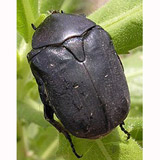 photo Rittner |
 photo Sabatinelli |
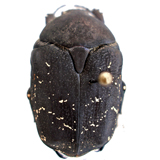 photo Sabatinelli |
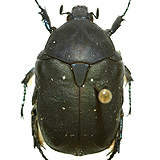 photo Rittner |
 from Tauzin |
 from Tauzin |
 from Medvedev |
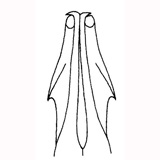 from Baraud |
 From Medvedev |
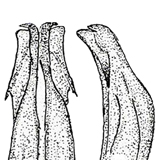 from Tauzin |
Protaetia (Netocia) afflicta ssp. servillii, Burmeister, 1842 (Cetonia) combinatio nova
Present in Sinai, Negev and South of Jordan (Wadi Rum)
 photo Sabatinelli |
References
Pierre Hubert Tauzin. 1994 - Precisions sur la repartition de quelques especes de Cetoniinae Palearctiques. Quatrieme note; Les Netocia Costa, 1852 (fin). L'Entomologiste, 50: 33-39 (Netocia afflicta). Download full article.